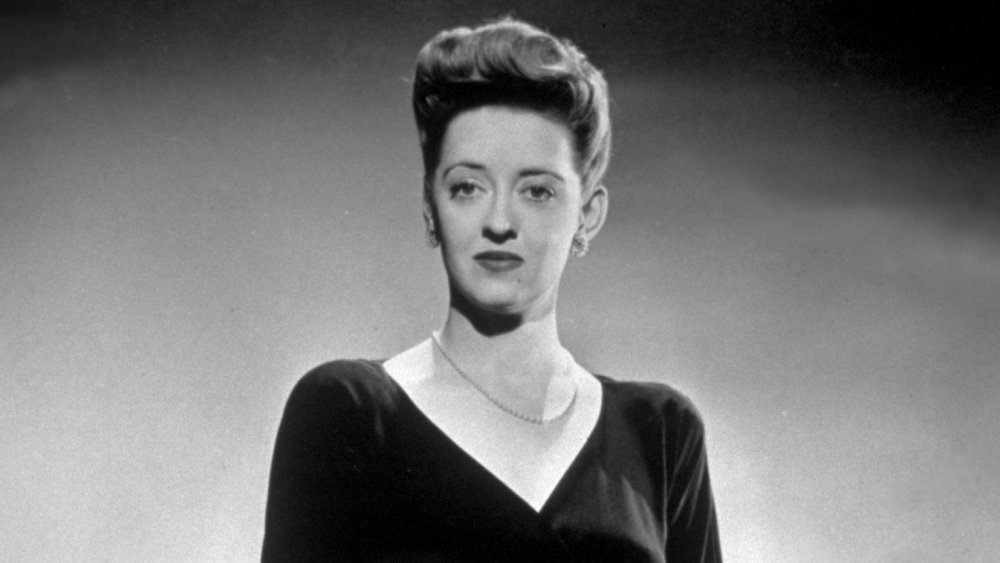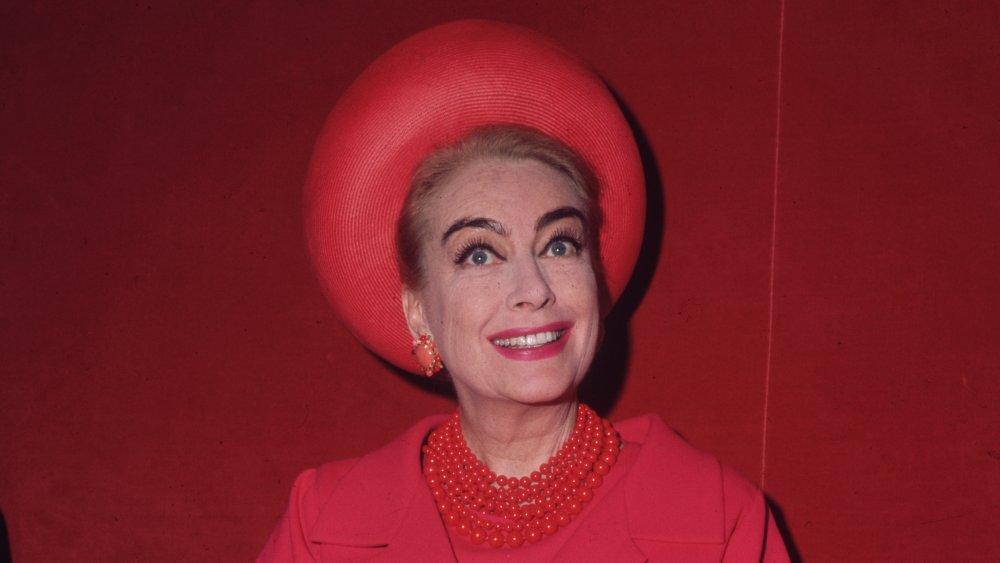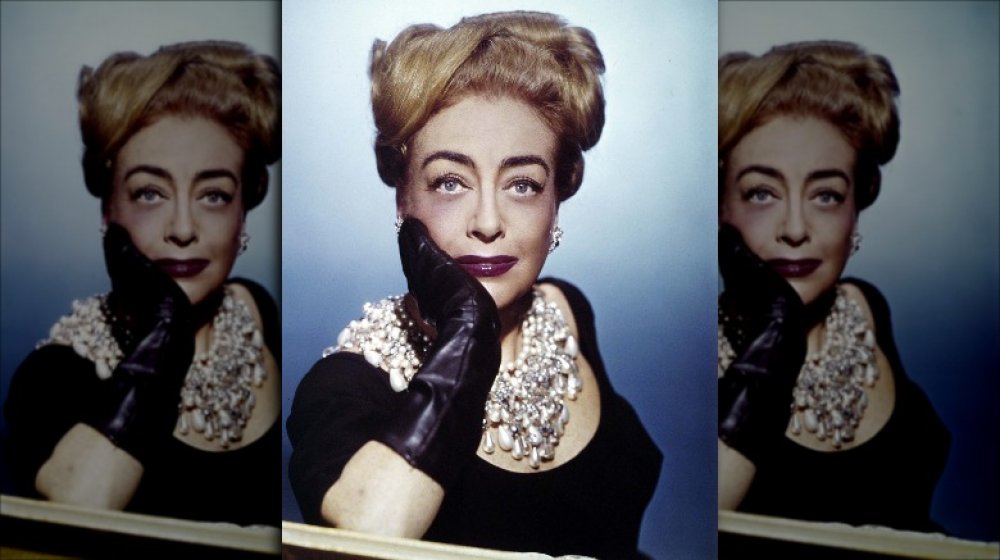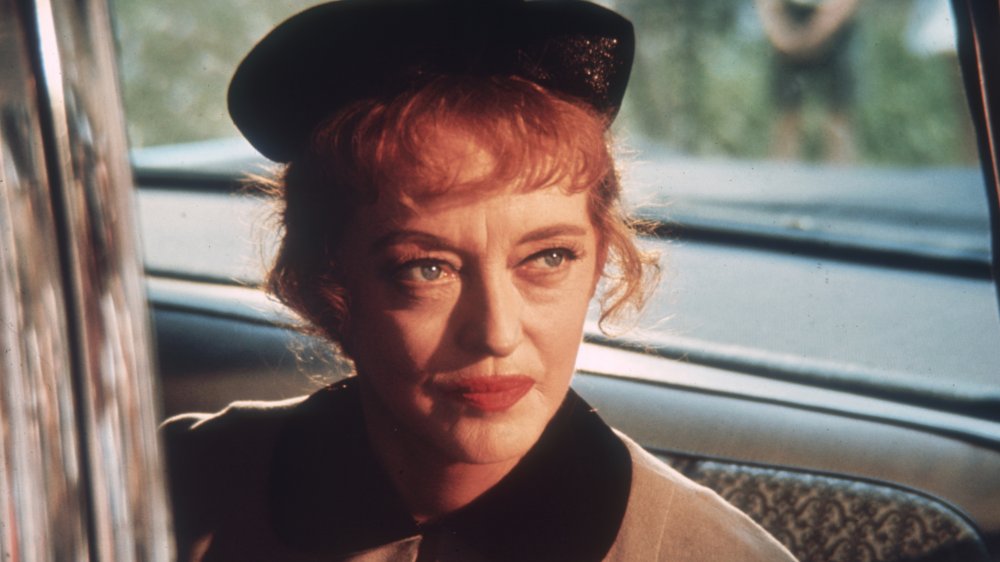The Truth About Bette Davis And Joan Crawford's Legendary Feud
"There was never a rivalry like theirs. For nearly half a century, they hated each other, and we loved them for it." So begins FX's 2017 miniseries, Feud: Bette and Joan, which details the iconic and real-life contention Hollywood starlets Bette Davis and Joan Crawford had with one another — one that lasted from the early '30s all the way to the late '70s. "That was a story and a feud of biblical proportions."
Both Crawford and Davis were members of the Tinseltown elite, the former getting her big break in 1925 and spending a hefty portion of her career "top-billed and swaddled in glamour" (via Biography). The latter, on the other hand, had a bit of a later introduction to the A-list, but as Biography notes, "became one of the biggest stars in the Hollywood studio system, appearing in nearly 100 films before her death in 1989."
So, what was the cause of such long-lasting resentment? As Vulture notes, the two "ruled Hollywood. Both were professionals: brave, fiery, and keen artists known for very different things." It's that last point, however, that really separated them. After all, the grass is always greener on the other side. It was a "battle sparked by both professional and personal resentments and fueled by an industry that loved nothing more than to see its women tear each other apart," writes Harper's Bazaar, and much of that is accurate. Let's find out the truth about Bette Davis and Joan Crawford's legendary feud.
A less-than-thrilling debut
Joan Crawford was already a Hollywood icon for five years by the time Bette Davis made her Tinseltown debut in 1930. Originally discovered in New York as part of a chorus on stage, Crawford signed with MGM in 1924. The Mildred Pierce actress was "an excellent businesswoman who, in her four-decade career, understood how to shift her looks to reflect the modern woman," writes Vulture, adding that she was better known for her looks than her acting talents.
According to Harper's Bazaar, Davis "reached a pivotal moment" in her rising career in 1933 with her first full-length flick, Ex-Lady, featuring her name above the title. As the outlet explains, "Warner Bros. had planned an elaborate publicity campaign announcing Davis' new phase of stardom" — yet this never came to fruition. That same day, Crawford declared she was "divorcing her first husband, Douglas Fairbanks Jr.," and of course, the fans gobbled it up.
In the end, "The New York Times relegated Davis' film to a small paragraph in the Review section, while devoting several pages to Crawford's news, and other papers followed suit." This was "the first public incident [...] of Crawford upstaging Davis, in what would become a recurring theme," writes Harper's Bazaar. Simply put, a feud was born.
The man-stealing incident
Bette Davis' first Academy Award win came in 1936 for her work in Dangerous — yet she wasn't solely after the coveted Oscar. As it turns out, the starlet had her eyes set on the flick's leading man, Franchot Tone. The problem? He was already engaged to Joan Crawford. "She loved everything about Franchot: his looks, his name, his elegance," mused Burt Reynolds in his memoir, But Enough About Me. Adding that he always assumed their rivalry was "natural," the Deliverance actor admitted that Davis herself revealed to him one night that Crawford had "kept her from marrying 'the love of [her] life,'" adding, "She took him from me. She did it coldly, deliberately, and with complete ruthlessness."
Soon after filming the 1935 movie, Tone married Crawford. It lasted a mere four years. According to an April 1939 article by The New York Times, "mental cruelty was the charge on which the screen star obtained her [divorce]." The formerly happy couple fought frequently, and Crawford claimed Tone wanted his freedom. "Shortly after our marriage," she told the judge, "when he asked me to go out socially and I refused because I had been working so hard [...] he became very angry and went out by himself."
Meanwhile, Davis divorced her first husband in 1938, so why she didn't swoop in and snag Tone remains a mystery. Her hatred for Crawford, however, only grew. "I've never forgiven her for that and never will" (via But Enough About Me).
Bette Davis' 'lovely frock'
Although Bette Davis was the new kid on the Hollywood block where Joan Crawford was already a shining star, it's the former who landed her Academy Award first. In 1936, the year after starring in Dangerous with co-star (and Crawford's then-hubby) Franchot Tone, Davis was nominated for Best Actress.
According to Harper's Bazaar, the starlet wasn't even interested in attending the ceremony, as she "didn't imagine she would win." What's more, Davis was signed to Warner Bros. at the time, and desperately wanted to be freed from her contract — so she used the Academy Awards as an opportunity to annoy Jack Warner. Per Vogue, the dress she wore was designed by Orry-Kelly, the same costume designer "who worked on films including Casablanca and Some Like It Hot." However, instead of making the actress a glamorous gown, "Davis specifically chose the design as she believed it looked like something the 'hired help' might wear — a direct protest aimed at Warner Bros.
When Davis eventually won the coveted award of the night, "legend has it that Tone got up and embraced her, while his now-wife Crawford refused to budge and kept her back to Davis" (via Harper's Bazaar). As Roger Moore wrote in his book, Last Man Standing: Tales from Tinseltown, it's believed that Crawford ever-so-ruthlessly said, "Dear Bette, what a lovely frock."
One woman's trash is another woman's treasure
As seen with her dress protest at the 1936 Academy Awards, Bette Davis wasn't shy about her disdain for working under Warner Bros. "I went to see Mr. [Jack] Warner, just, you know, as a last hope because I was fighting for good directors and good scripts," the actress revealed years later on The Dick Cavett Show. Sure enough, by 1937, Davis flew across the pond to make movies — a direct breach of her studio contract. "When Warner Bros. received word of this, Davis took them to court" and lost, returning to Hollywood to yet again continue verbally sparring with Warner (via Bella Online).
According to The Hollywood Reporter, during her time away in England, Davis "turned down the role of a lifetime as Scarlett O'Hara in Gone with the Wind." In 1945 she did the same thing again, yet this time, Joan Crawford was there to pick up her scraps. Per Harper's Bazaar, Davis' rival snagged the lead in Mildred Pierce.
Crawford ended up winning her first and only Oscar in 1946 for her role in the now-iconic flick, and in true Crawford fashion, accepted it like a diva. As Refinery29 reveals, instead of showing up to the Oscars, the starlet claimed "that she was too nervous to leave her room" — at home. That's right, in full hair and makeup, Joan Crawford posed in her bed, clutching her gold statue as photographers snapped their official publicity shots. Iconic.
Rivals? Yes. Potential lovers? Probably not
Even after her failed lawsuit and turning down parts both in Mildred Pierce and Gone with the Wind, Bette Davis was still dictating the roles Hollywood was throwing at her. In 1950, she famously refused to star in the female prison movie, Caged. As Hollywood's Golden Age explains, Warner Bros. wanted her to star opposite Joan Crawford, yet Davis brushed it off as a "dyke movie" and canned the idea. Was there any truth to what she was saying, however? Some seem to think so.
According to Harper's Bazaar, it's around this time that a curious rumor began spreading: that Crawford was secretly in love with Davis. "Franchot [Tone] isn't interested in Bette, but I wouldn't mind giving her a poke if I was in the right mood," joked the Oscar-winning actress to her friend, Jerry Asher (via Joan Crawford: The Essential Biography).
But why would Crawford be lusting after her nemesis? As Asher explains, "I do think Joan was attracted to Bette's vitality and energy. Mostly she wanted to be Bette's friend because she admired her ability and sensed some similarities between them." As for Davis? "Bette was always convinced, due to her ego, that Joan had the hots for her and that's one reason why she was always so antagonistic and called her a phony."
The movie mockery of Joan Crawford
1952's drama, The Star, tells the story of "Margaret Elliot, an Academy Award winning actress who has not worked in several years," chronicling her "downward spiral" (via TCM). Sound familiar? Well, it should, as the character of Margaret very closely resembles that of Joan Crawford.
As it turns out, The Star was written by Crawford's ex-friends, Katherine Albert and Dale Eunson. As the movie went into production, "the couple's 25-year friendship with the actress ended." So, who was offered to play the lead? None other than Bette Davis. "Frankly, it was a little too close to [Crawford], which is one reason Bette liked it," explained Eunson (via TCM). "Bette could play Joan Crawford to the hilt." While Davis gushed about the script, calling it "one of the best [...] ever written about a movie mad actress," it tanked at the box office — but that wasn't enough for Crawford, who, of course, sought revenge.
According to Shaun Considine's Bette and Joan (via TCM), Crawford was fully aware of the flick's mockery of her. Being as she was the godmother of Albert and Eunson's daughter, Crawford found out during The Star's production that "the 17-year-old girl decided she wanted to get married." When the couple asked the starlet to speak to the girl and talk her out of it, Crawford instead "arranged the wedding in her house and later called the Eunsons to tell them their daughter was married." Clever? Yes. Shady? Absolutely.
Their first and only movie together
By the time the '60s came around, both Bette Davis and Joan Crawford were fading stars past their prime. As People writes, as the pair "entered their 50s," work was suddenly hard to come by, with Tinseltown execs clambering to hire younger sex-symbols such as Marilyn Monroe, who was at the peak of her career.
"It was Miss Crawford who brought me What Ever Happened to Baby Jane?" revealed Davis to author Charlotte Chandler in Not the Girl Next Door: Joan Crawford: A Personal Biography. "I was rather surprised to see her." Davis surprisingly agreed to star alongside her rival in the horror flick — on two conditions: that she play the lead, and that director Robert Aldrich wasn't sleeping with Crawford. "It wasn't that I cared about his private life, or hers either," the actress explained. "I didn't want him favoring her with more close-ups."
Aldrich, who was known at the time for his war flicks, suddenly found himself in the middle of a real-life war: that between the two legendary starlets. Per Harper's Bazaar, "it became remembered most powerfully as a public document of their real-life rivalry," with one report of Davis even hitting Crawford too hard in the head for one scene and the latter requiring stitches. Davis claimed she "barely touched her," but Crawford got her revenge: by allegedly wearing a hidden weightlifter's belt for a scene where Davis had to drag her — and "deliberately [ruining] several takes."
And the Oscar goes to... someone who wasn't nominated?
Considering What Ever Happened to Baby Jane? had two Hollywood heavyweights starring in it, both Joan Crawford and Bette Davis must have been nominated for Oscars, right? Not exactly. According to Celebrity Feuds!, "many critics felt Blanche could have been played by any actress, while Bette's tour de force performance as Baby Jane Hudson was unique, riveting, and unforgettable." Davis was at the brink of accomplishing something legendary in Tinseltown: the chance to be the first actress to win three Academy Awards.
Joan Crawford, naturally, wasn't going to give up without a fight. She contacted Davis' fellow nominees "and offered to accept their Oscars for them should they win and not be able to attend." As detailed by Vanity Fair, the night of the event, Crawford then commandeered the entire main dressing room and turned it into her own viewing party, filling it with various drinks and food.
As both women made their way to the stage wings as Swiss actor Maximilian Schell began announcing the nominations for Best Actress, the show's director Richard Dunlap had the opportunity to set up cameras at the wings to catch the iconic moment. But "I couldn't," he told Inside Oscar (via Vanity Fair). "It would have been cruel." As Anne Bancroft's name was called for her performance in The Miracle Worker, Crawford took the stage — and later even posed with all the Academy Award winners and their trophies.
They almost filmed another movie together
Nobody expected What Ever Happened to Baby Jane? to be the success that it was. As The Hollywood Reporter writes, "it was a low-budget film starring two 'washed-up' actresses in Joan Crawford and Bette Davis." Nevertheless, it ended up being a surprising box office hit — causing director Robert Aldrich to want to dive into the trenches again.
Per TCM, Aldrich approached Crawford and Davis once more after securing Hush...Hush, Sweet Charlotte, a short story written by Henry Farrell — the same author behind the original Baby Jane book. Per What Ever Happened to Robert Aldrich?, Crawford was allegedly "still incensed by Davis' attitude on Baby Jane and did not want to be upstaged again, as Davis' nomination for Best Actress convinced her she had been." She agreed to do the 1964 flick only if her name came first in billing, while Davis only signed on if she was paid more.
Crawford lasted a measly four days of filming until she reportedly feigned an illness, causing production to stop and Aldrich going as far as hiring "a private detective to record [Crawford's] movements." Eventually, the "production insurance company insisted that either Crawford be replaced or the production canceled." His hands tied, Aldrich replaced the legendary starlet with one of Davis' close friends, actress Olivia de Havilland. According to media historian Hal Erickson, Davis kept the shade going by "[pulling] a 'Ding Dong the Witch is Dead' routine" after Crawford left (via TCM).
One dies, but the feud continues
Joan Crawford passed away from a heart attack on May 10th, 1977. As Biography notes, while What Ever Happened to Baby Jane? sort of "revitalized" her career in 1962, she didn't match its success with her following projects, eventually settling for television work. As she mused in her 1971 memoir, My Way of Life, "Hollywood gave me a wonderful career. Maybe I was the one who gave myself [...] untold loneliness. But never bitterness."
You'd think after one half of this legendary feud passed away, the other would finally lay the rivalry to rest, too. Absolutely not. As Backwards and in Heels writes, Bette Davis allegedly used one final opportunity to quip about Crawford after her passing, cruelly declaring, "You should never say bad things about the dead, you should only say good. Joan Crawford is dead. Good."
While it may be totally juicy to think about Davis saying something so petty, is this a case of old Hollywood lore? Writer and director Peter Jones seems to think so, telling NPR in 2006, "I believe those were her sentiments. [Yet] I could never find her actually saying that. So..."
Bette Davis finally stands up for Joan Crawford
A year after Joan Crawford's passing, it looked like Bette Davis was finally ready to retire her almost-century long feud with the late starlet — thanks to Crawford's adopted daughter, Christina.
In 1978, Christina wrote her now-infamous memoir, Mommie Dearest (via The Guardian), a brutal tell-all which depicted Joan "as a cruel, abusive alcoholic." According to The Guardian, it was "the first book to talk so openly or with such clarity about a childhood allegedly punctuated by psychological and physical abuse." Naturally, people lapped it up, and Crawford's "reputation took a battering so ferocious that it has never fully recovered."
So, Bette Davis must have reveled in the news, right? Surprisingly not. As she told a Vanity Fair writer years later while working on her own memoir, "I was not Miss Crawford's biggest fan, but [...] I did and still do respect her talent. What she did not deserve was that detestable book written by her daughter. I've forgotten her name. Horrible." Adding that while she looked at the book, Davis actually never read it, denouncing it as "trash." Heartbreakingly enough, she admitted, "I felt very sorry for Joan Crawford, but I knew she wouldn't appreciate my pity, because that's the last thing she would have wanted—anyone being sorry for her, especially me."
The legendary catfight is brought back to life thanks to Feud
While reading about Bette Davis and Joan Crawford's iconic feud may seem entertaining and salacious, there's genuine sorrow hiding behind their glamorous lives.
In 2017, Ryan Murphy released Feud: Bette and Joan, an eight-part miniseries that showcases the making of What Ever Happened to Baby Jane? As the producer-writer-director told the Los Angeles Times, "Feuds are not about hate, they're about pain." Although Feud has moments of clever comedy, Murphy attests he had an even stronger agenda for audiences to take away. "This show is not funny or campy. It's much more painful and heartfelt than people will think. They had so much in common — two legends who turned 40 in the 1950s and couldn't get work. Everything around them — the studio system, their own egos — conspired to keep them apart."
With Jessica Lange as Crawford and Susan Sarandon as Davis, Feud was a hit. As Lange so wisely told the Los Angeles Times, "All the political themes we're dealing with — sexism, ageism, misogyny — are still here, making this very personal and profound."












